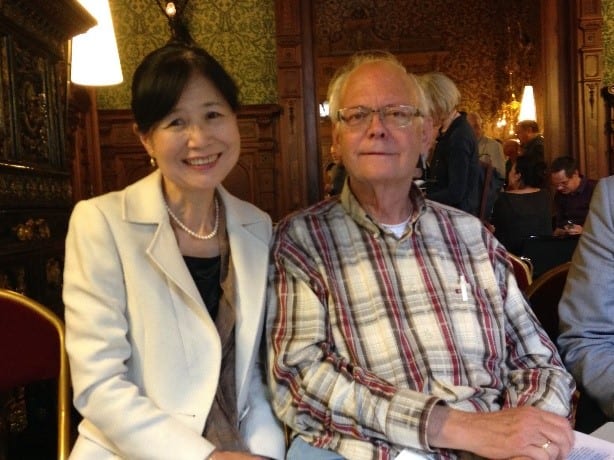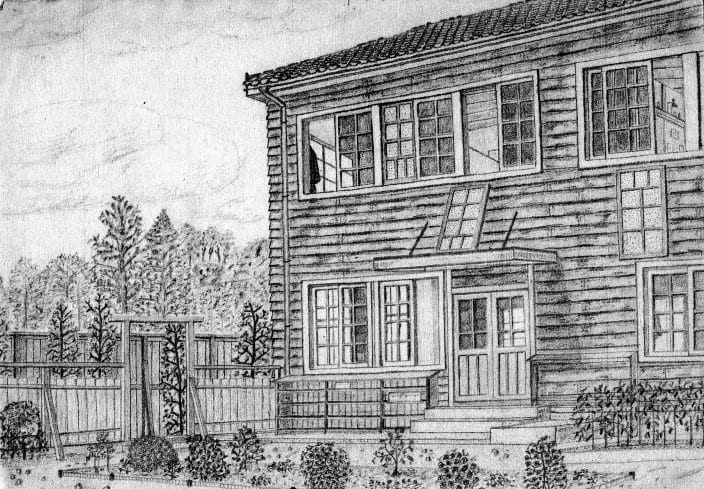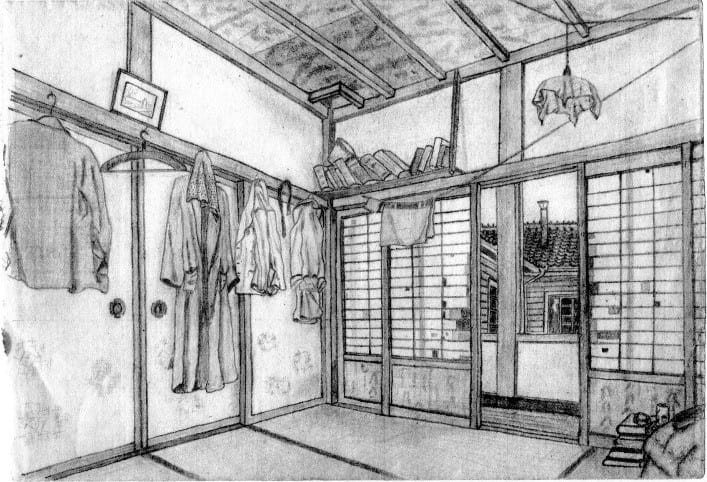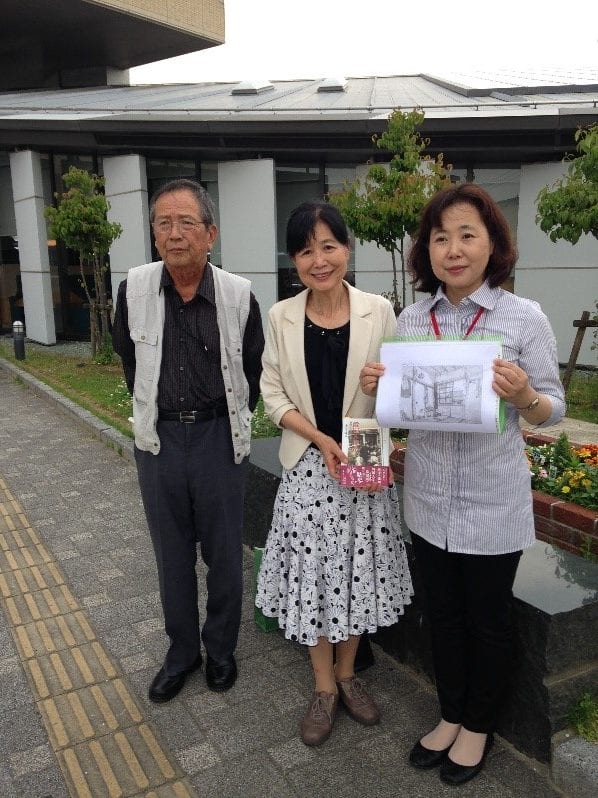The meeting with Mr. Koeverden
On June 3rd, 2016, I, with some members from POW Research Network Japan, attended a symposium, which was held in the museum named NIOD in Amsterdam to talk about POW camps built by Japan during WWII. I gave a presentation titled “Dutch civilians who were interned in Japan during World War II” there.
After my presentation, one Dutchman in the audiences said that his father was captured by Japan from the hospital ship named ‘Op ten Noort’, was brought to Japan and was interned in Miyoshi camp. And he wanted to know about Miyoshi camp.

That was how I came to know Mr. Jan van Koeverden.
Never having expected that the family member of the crew members of the ‘Op ten Noort’ was in the symposium, I was so surprised. After the symposium, Mr. Koeverden and I talked each other about Miyoshi camp. He showed me the list of the 42 POWs interned in Miyoshi camp which was seemed to be gotten by himself from the National Archives in Den Haag. His father’s name was on the list.
He also showed me some drawings of the Miyoshi that camp his father drew. Then he told me about his father, whose name was Mr. Gerrit van Koeverden. He was a medical doctor working at the hospital in Sumatra Island. But when the war broke up, he was called by Dutch Navy to work on the hospital ship ‘Op ten Noort’. He was captured by Japanese Navy then.
While his father was a captive in Japan, Mr. Jan Koeverden and his mother were also interned in the camp in northern part of Sumatra island. He had to stay in the camp until the war ended. He couldn’t speak those stories to me without tears.
It was my first time to know that there were the civilian internee camps in Sumatra. I, of course, knew that there were many civilian internee camps in Java built by Japan. When the war started Japan invaded and occupied Dutch East Indies, every Dutch people living in Dutch East Indies was interned in the camps including women and children. But I could hardly imagine that there also were civilian internee camps in Sumatra, nor that the family members of the crew of ‘Op ten Noort’ were interned there.
I was so shocked to see his tears. The tears were telling me how passionately he had been thinking of his father who became a POW, and how hard his own internee life was. I realized that not only his father but also he himself was a war victim.
Aik Pamienke camp in Sumatra
After I came back to Japan, Mr. Koeverden and I started to exchange e-mails.
He wanted to know a lot about Miyoshi internment camp, in which his father had been taken. And he also requested the information about the hospital ship, the ‘Op ten Noort’. At the end of June, I sent him a book named “kaigun byouinsen wa naze shizumeraretaka” (Why Naval Hospital ship was sunk) written by Kunitaka Mikami, published in 2001. He seemed to be interested in that book but he couldn’t read it because it was written all in Japanese. He could only enjoy seeing the pictures of the ‘Op ten Noort’ and one picture of Miyoshi internment camp building taken before the war. He was surprised that ‘Op ten Noort’ was more famous in Japan than in the Netherlands.
Meanwhile, I asked him where in Sumatra he was interned, and how was his internment life. I was ashamed of my ignorance about the camp. I should have known more about the internment camps in Sumatra.
Mr. Koeverden answered my questions in the e-mails in July. His stories seemed to be based on his memories of his childhood. Those were as follows:
Before the war, the Koeverden family lived in the town named Wingfoot, which was at around 30km east of Rantauprapat of north Sumatra. His father (Mr. Gerrit Koeverden) was working as a medical doctor in a hospital. After the war broke out On December 8th, 1941, Gerrit was called on duty for the Dutch Navy, and got involved in the war as a doctor on the hospital ship ‘Op ten Noort’. Then on February 28th, 1942 the battle of the Java Sea broke out, and Dutch Navy was defeated by Japanese Navy. The crew members of the ‘Op ten Noort’ including Gerrit were captured and sent to Japan.
Meanwhile, Mr. Jan Koeverden and his mother were interned in Aik Pamienke Camp at the north of Rantauprapat, which was established in October 1942.
After the war ended, Jan and his mother were liberated by the English troops from the Aik Pamienke I Camp. (Aik Pamienke I Camp seems to have been established in April 1945, around 1380 women and children were gathered from north Sumatra. This information is from the site “East Indies camp archives”
https://www.indischekamparchieven.nl/en/search?mivast=963&miadt=968&miahd=798141831&miaet=14&micode=kampen&miview=ika2
And they were brought to Medan in September. Jan went to a missionary school in Medan when he was a six-year-old boy, and they were transferred to Singapore after about half a year. In Singapore, they were put into a refugee camp called “Wilhelmina Camp”. He was 7 years old there.
In the Wilhelmina Camp, all the Dutch former prisoners were divided into two groups by the British. One is to go back straight to Holland. The other is to stay in Dutch East Indies.
Their destination was decided on whether they had any family member in Dutch East Indies who had survived the war. If not, they were forced to book a ship going straight to Holland.
His mother, however, did not know if Gerrit survived, she didn’t even know where he was during the war. Then she wrote some letters to their families in Holland to get some information.
They had to wait so long because the letters from Singapore to Holland took one month by boat and the return post as well. They had to stay in the Wilhelmina Camp at least half a year. She finally figured out that Gerrit survived the war, and he was in Batavia working for the Royal Dutch Navy.
She managed to figure out his exact address in Batavia. Then they booked the earliest flight to Batavia and they ran across the city of Batavia in the car prepared by the navy to find Gerrit.
When they arrived at his place, Gerrit was taking rest because it was noon. Jan’s mother met Gerrit after 4 and half years, and she said to Jan: “This is your father.”
After spending two years in Batavia They left for Holland by the cruiser boat “Oranje” and Gerrit got a job in the Dutch Navy in Den Helder, the main navy port in Holland.
Gerrit died in 1979 at the age of 74. Jan’s mother died in 1996 at the age 89.
Although his story was interesting and thrilling, he didn’t say anything about his internment life in Sumatra. That was maybe because he was too young to remember these days, or they were too miserable to talk about.
The drawings of Miyoshi Internment Camp
The end of August 2016, Mr. Jan Koeverden sent me ten copies of wonderful drawings his father drew in 1944.
Some drawings sketched Miyoshi internment camp buildings. In the drawings, each building was connected by a breezeway, windows were wide, hedges and flowerbeds surrounded the buildings. They rather looked like school buildings than POW barracks.


Some drawings sketched inside of the internee’s room. Many belongings of internees like clothes, books, towels were in the rooms. No one had ever seen such scenes. Those drawings showed us the reality of the life of internees.
One drawing was a sketch of the dining room. There is a photo of that room photographed before the war. I compared the photo with the drawing. And I found the drawing really correct and similar to the photo even in the details.
One drawing drew a gateway of a railway tunnel in the background of the building. I easily found that it was a tunnel of Sangou Line, which is used till now.
Nine of them were monochrome because they were drawn by pencil. Only special one was drawn in color-ink, and that was a sketch of the ‘Op ten Noort’. The Red Cross on the funnel was painted vivid red and line on the body of the ship was painted vivid green.
I was very moved by those drawings. They are not original drawings but copies. Jan made excellent copies in the Netherlands. I believe they are as beautiful as original ones.
I was convinced that those drawings were totally valuable. Jan wrote the letter which was enclosed with the drawings saying that “I am only interested in what you are going to do in my drawings.”
I thought those drawings should be stored in the museum. One set of copies are appropriate to be stored in NIOD in Amsterdam. The other set of copies should be stored in Miyoshi. If there isn’t any good museum in Miyoshi, the library in Miyoshi should store them. The drawings would be important documents of local history.
Jan was strongly interested in Miyoshi, where his father was interned in for three years. I thought that Jan should come to Japan to visit Miyoshi. If he could visit Miyoshi and give the copies of the drawings to a museum or a library, they would receive the drawings.
Then I recommended that he should apply for the invitation program which was carried out by the Japanese government. That program invited some Dutch ex-POWs or internees who were interned by Japan during WWII. Every year one group consisted of around fifteen ex-POWs or internees is invited. He can apply for the invitation program because he spent his childhood days in an internment camp in Sumatra.
He got interested in that program and started to gather information by himself. But he finally abandoned the application because there were so many applicants waiting, he was anxious about his health, and the program doesn’t include Miyoshi.
Then at the end of 2016, he decided to come to Japan with his son at his own expense. I was so happy to know his decision by e-mail. I started preparing to welcome him with a sense of tension. I asked Mr. Yonemaru, who was a local historian and knew a lot about Miyoshi camp, to guide us in Miyoshi city. And I asked Ms. Tamura, who was a member of POW Research Network Japan and good at English, to be an interpreter for us.
In March 2017, however, I got an e-mail from Jan saying that he was not able to come to Japan because his health was declining. I was very sorry to hear that.
The travel to Miyoshi
I was so disappointed to know that Jan couldn’t come to Japan. I thought at least I could go to Miyoshi to deliver his drawings. And if I could go to Miyoshi I could report to him what kind of place Miyoshi was nowadays. So, I wrote a letter to the director of Miyoshi City Library and appealed the value and importance of the drawings for Miyoshi local history. I also asked the director not only to store the drawings but also to exhibit to the public.
Fortunately, I got the answer that the Library would receive the drawings.
I asked Jan to make “Permission to publish” for the drawings, then he made it soon and sent me by postal service. I went to Miyoshi city in Hiroshima Prefecture to deliver the drawings with his “Permission to publish” from May 31st to June 1st, 2017.
On the afternoon of May 31st, I arrived at Miyoshi Station. Mr. Yoshikazu Yonemaru, who is a local historian, welcomed me. And he guided me in Miyoshi city in his car for two days. First, we visited Miyoshi City Library and gave the drawings and the permission to the director, Ms. Nanae Arimitsu. She called the press, and I was interviewed by Chugoku Newspaper.

Then Mr. Yonemaru and I went through the city to visit the Arase hospital. Miyoshi was beautiful small castle town. Arase hospital was established over one hundred years ago. And in the wartime doctor, Hidetoshi Arase performed an operation on one of the Dutch internees, who was a nurse. And doctor Arese saved her life. We met doctor Toshikata Arase, who is a grandson of Hidetoshi, and we talked about Dutch internees interned in Miyoshi.
The next morning, we visited Aikou preschool, which was a former internment camp. That preschool was established in 1938. When the war started the preschool building was taken over by the police and was used as an internment camp for enemy foreigners. From December 1942, the crew members of the ‘Op ten Noort’ were put into that place. 42 Dutch including Jan’s father and 2 Indonesians were interned there. Internment of enemy civilians was a secret, so Dutch crews were isolated from the world and stayed there for two years and nine months until they were liberated in September 1945.
Now the preschool building is reconstructed, many children were playing there. We met Ms. Mineko Izumi, who was the director of the preschool. She guided us the building. From upstairs we could see mountains and a railroad bridge. Those looked exactly like the drawings Jan’s father made. Jan asked me by email, “If there was a memorial for remembering of the camp or somewhere suitable place else in Miyoshi, please put a tulip flower on there to a remembrance of my father”.
I tried to get tulip flowers but they were out of season, so I got some tulip bulbs instead and gave them to Ms. Izumi. I hope they will bloom next spring.
At that morning, Chugoku Newspaper already carried the article headed “the sketch of Miyoshi internment camp” And Miyoshi City Library started to exhibit the drawings of Miyoshi camp from June 6th. Therefore, so many people from the inside and outside of Miyoshi came to see those drawings.
Mr. Kado, who is a journalist of Asahi Newspaper Osaka head office, also interviewed us. And June 24th Asahi Newspaper carried a big article about Miyoshi internment camp and the drawings. Miyoshi internment camp seemed to have become a little famous in Kansai area.
Jan appeared in NHK
I completed the mission successfully which started just one year ago. I reported Jan the details of the travel to Miyoshi. He wrote me that “the drawings got a perfect destination”, then I felt relieved. But it wasn’t the end of the story concerning Miyoshi Internment Camp.
At the beginning of July 2017, I got a call from Mr. Terashima, who is a director of NHK TV. To my surprise, he asked me to arrange an interview with Jan. Because NHK TV was going to televise about the ‘Op ten Noort’, which was sunk by Japanese Navy in August 1945, just after the war ended. It was quite coincident. They already had found and filmed the body of the ‘Op ten Noort’ sank in the sea offing of Tango peninsula. Mr. Terashima was really interested in Miyoshi camp, in which the crew members of the ‘Op ten Noort’ was interned. He actually read the article on Asahi Newspaper about the Miyoshi camp written by Mr. Kado.
NHK was the biggest broadcasting company in Japan. That was quite a big chance. I suggested to Jan that he should accept an interview by NHK.
On August 5th, three of NHK staff visited Jan’s house in Diemen near Amsterdam, he pleasantly accepted the interview. After that Jan sent me an email saying, “The interview was very interesting to me. I never experienced a TV interview by such a great company as NHK.” He seemed to be really looking forward to seeing his appearance on the TV.
That program was televised on August 25th. But unfortunately, Jan couldn’t watch it. Even I also couldn’t watch it because that was broadcasted to a limited area in Japan. We had to wait to get the DVD which would be sent by Mr. Terashima.
On September 1st, the DVD was sent to me, and I watched it immediately. In the TV he looked nice and seemed to be in good health. In the interview, he was eagerly talking about the rights that hospital ships had according to the international law. There was a close-up scene of his father’s photo on the identification card of Dutch Navy. In another scene, he was showing his father’s drawing of the camp building. And he explained that after the war ended, his father asked where the “Op ten Noort” was. But Japanese government didn’t answer the truth.
Of course, the war was terrible. Now young people don’t know about true war, or almost every Japanese doesn’t know about the history of the “Op ten Noort”. So, this TV program was good for every Japanese. I was glad that it was televised.
I emailed Jan my impression about the DVD. But I never got his reply no matter how long I waited.
On September 25th, I got a letter from Mrs. Ekie van Koeverden, Jan’s wife. She wrote that Jan died of a heart attack on September 4th. He was born on August in 1938, so he was 79 years old.
It was such a sad and regrettable message.
I met Jan only one day on June 3rd, 2016, but we exchange over 40 e-mails.
I carried his father’s drawings to Miyoshi City Library. The drawings were stored in the Library. One year ago, he was afraid if he would die before he could get somebody to give the drawings. If he could give the drawings to someone, that person should know the value of the drawings.
Now the original drawings were stored in NIOD in Amsterdam, and good copies were stored in Miyoshi. He said, “The drawings got a perfect destination.” Maybe he was satisfied.
And the drawings were exhibited in the library and published in the newspapers. Therefore, many Japanese have a chance to know the POWs and the war.
Moreover, it brought about Jan’s TV interview, and he appealed the unlawfulness of the “Op ten Noort” incident against the international law in wartime.
Everything unfolded miraculously starting from just a small meeting at NIOD.
The remaining subject
Mr. Jan Koeverden was interned in the camp when he was a little child. He had had quite a difficult time until he came to be able to live with his family after the war. Almost every Dutch people living in Dutch East Indies had similar experiences. But the most of Japanese don’t know about that, even it was a result of Japanese invasion. I think it is not fair. I can’t hear any more experiences from Jan. But I will continue to research on the Internment camp in Sumatra and I want to publish the findings in some form.
December 30, 2017

My name is Karin Ina Ingwersen and I live in Cape Town, South Africa – and by complete chance I got sent this link about Gerrit Koeverden in Myoshi camp from a Dutch friend.
My aunt HMJE Den BOER (called Yona) was in this exact camp as well. I have all her accounts of this time: letter to her mother after 3 1/2 years silence; a kind of diary note book; her medical kit; epaulettes etc; documents; the full list of interns and nearest of kin; the full account of the ulcer operation on Lot Brouwer typed by another sister AE de Boer-van Waring Bolt, on many pages with noteworthy references of context and circumstances as sent in original envelope to my aunt by the author before she passed; a statement by the captain of Op ten Noort, a photo of the building taken later – and an album of drawings – now at last I know who the artist was! I am delighted to have this opportunity to contact you!
My aunt eventually came to live in South Africa, around 1953 after Batavia post camp, brought her mother from Holland with her- to be near her sister – ie my mother Ine and father Linus Ingwersen and our family, near Pretoria.
She returned to Holland 1965, and I fetched her at 101 years age when her companion died in 2003. She stayed with my mother Ine, now also in Cape Town, where she died, a few weeks short of 104th birthday.
She was without doubt a fascinating woman an no doubt my favourite! We were quite close and I frequently visited her in Holland until I fetched her as I had promised.
I look forward to hear from you.
Regards from Cape Town.